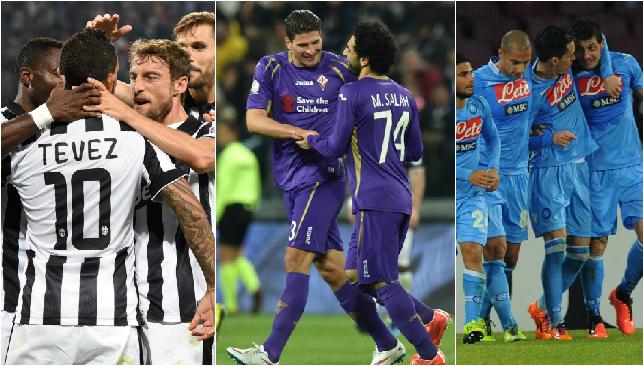
On Friday, Juventus were drawn against Real Madrid in the Champions League semi-finals, the Bianconeri making their return to the final four of UEFA’s elite competition after a 12-year absence.
– VIDEO: Morocco beat Spain in dramatic F5WC final penalty shootout
– PLC announces categories for 2014/15 AGL Awards
– #360view: Yaya Toure needs to make his intentions clear to Man City
It has been a long road back to the top for the Turin giants, who have been relegated during the fallout of the Calciopoli scandal and changed coach no fewer than nine times since finishing as runner’s up to AC Milan back in 2003.
Now clearly establishing themselves back among the elite, the Bianconeri are also in the midst of a prolonged spell of domestic dominance, clinching the Serie A title by a comfortable margin in each of the last three seasons.
Juventus to the semi finals of the Champions League, Fiorentina and Napoli to the semi finals of the Europa League! Making Serie A proud!
— Curtis McNeill (@LateFiddle392) April 23, 2015
No other side from the peninsula reached the knockout stage of the Champions League this season, while Juve have also secured a place in the Coppa Italia final and are currently a staggering 15 points clear at the top of the standings with just seven games remaining.
Taking all those things into consideration, it is relatively easy to conclude that Italian football is struggling to keep pace with La Madama, and yet looking around there are plenty of reasons for optimism.
Both Udinese and Sassuolo have followed the Turin giants in effectively owning their own stadiums, while – despite their continued on-field struggles – new ownership has clearly begun to steer both Inter Milan and AS Roma towards a more modern approach.
The Europa League has also presented the division’s other teams with an opportunity to shine, and their progress there certainly hints at a league which is enjoying a healthy resurgence after years in the doldrums.
No fewer than five sides went through to the last sixteen of the competition, with Torino FC doing so by virtue of eliminating Athletic Club de Bilbao, marking the first time an Italian side had recorded a knockout victory over a Spanish opponent since Jose Mourinho’s Inter saw off Barcelona back in 2010.
Jose Mourinho lifts the Champions League trophy after Inter defeated Bayern Munich in 2010. pic.twitter.com/mnrM1jTEEs
— TweetChelseaFC (@TweetChelseaFC) April 9, 2015
Superbly organised by Giampiero Ventura, the Granata overcame the sales of leading scorers Ciro Immobile and Alessio Cerci to enjoy a fine campaign, eventually succumbing to Zenit Saint Petersburg by the narrowest of margins.
Inter themselves got past Celtic before being thoroughly outplayed by Wolfsburg, who in turn were soundly beaten by Rafael Benitez and Napoli in the quarter-finals. AS Roma and Fiorentina were unfortunately drawn together in the last 16, with LaViola emerging victorious and going on to win a place in the semi-finals.
It is a return to the 1990s heyday for Serie A, the league providing no fewer than thirteen of that decades finalists, with the showpiece being an all-Italian event no fewer than three times in that ten year span.
when you think the bpl is the best league in the world think again Serie A is ahead of it @RMvsGaming @FutRichAiden pic.twitter.com/JQ3t69e308
— E15K (@Gunners1888) April 26, 2015
At a time when other nations appear to be actively avoiding qualification for the Europa League, it seems somewhat strange to see Italian football taking the competition so seriously. This is most obviously apparent in England, where a number of clubs believe their interests are best served by missing out on what they perceive to be simply added fixture congestion.
Allied to the improved showings from Serie A, this apathy has seen the gap between them and UEFA’s three highest ranked nations close considerably, though it is unlikely they can overtake either England, Germany or Spain anytime soon.
That means Italy will continue to only have three places in the Champions League, and – rather than a common desire for co-efficient points – it is that fact which has driven this new-found impetus in the secondary competition.
The decision to award a Champions League group stage berth to the winners of the Europa League is the perfect incentive for Serie A, where Juventus are almost guaranteed to take one of the three places, leaving the rest to battle for just two spots.
Roma and Lazio currently occupy those berths, and sit some five points ahead of the chasing pack, in turn prompting the rest to seek an alternative route.

Napoli will hope the vast European experience of Benitez – who is looking to reach his fifth major final with his fourth different club – can help them to overcome Dnipro as the San Paolo hosts a continental semi-final for the first time since Diego Maradona lifted them to glory in this competition 26 years ago.
Fiorentina face a more difficult task against current holders Sevilla however, are unbeaten at their Sanchez Pizjuan home for almost 14 months now, a record LaViola – led by the irrepressible Mohamed Salah – will hope to end.
“It would be a great sign for Italian football if Napoli and Fiorentina both reached the final,” Lorenzo Insigne commented to Mediaset earlier this week. It most certainly would, and on recent performances it would not be a surprise should that happen in Warsaw next month, as the Europa League continues to help Serie A on its path to recovery.